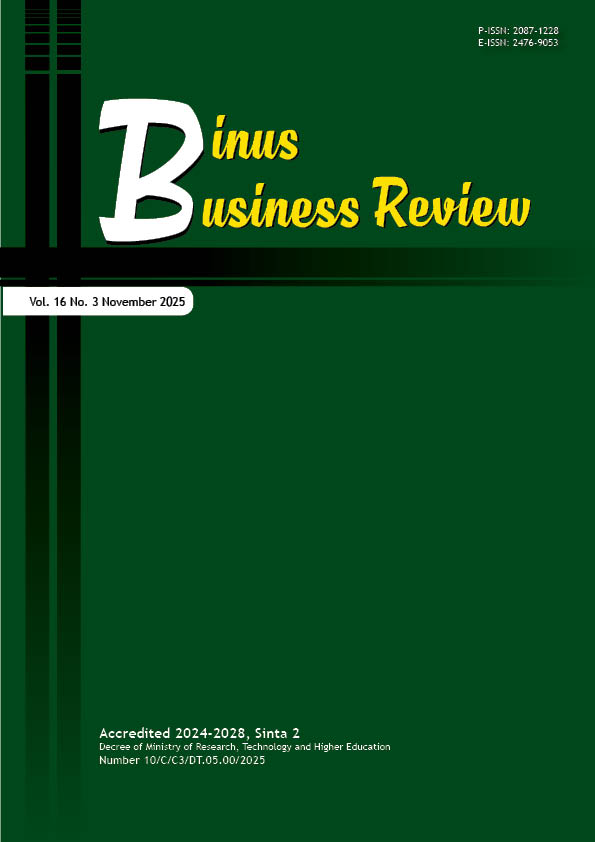Ecolabeling, Green Advertising, and Branding: Drivers of Green Purchasing Behavior Among Generation Z
DOI:
https://doi.org/10.21512/bbr.v16i3.13388Keywords:
ecolabeling, green advertising, green branding, green purchasing behavior, Generation ZAbstract
Generation Z is highly aware of sustainability and environmental issues, yet skepticism toward sustainability claims and the prioritization of product quality and price pose challenges to green marketing effectiveness. The research examined the influence of green marketing strategies on Generation Z’s consumer behavior in influencing green purchasing behavior. The research explored three key elements of green marketing: ecolabeling, green advertising, and green branding. It also assessed the mediating roles of environmental knowledge and green consumption in shaping green buying behavior. A quantitative survey was conducted among 400 Generation Z consumers in Indonesia, and the data were analyzed using Partial Least Squares Structural Equation Modeling (PLS-SEM). The findings reveal that green marketing strategies significantly impact environmental knowledge, which subsequently influences green consumption and green buying behavior. Transparency in sustainability claims, clear communication of product benefits, and consumer education on environmental issues are essential in fostering trust and engagement. The research offers originality by integrating environmental knowledge and green consumption as mediators in a Generation Z context, providing new empirical insights into how green marketing strategies influence this demographic. It contributes theoretically to consumer behavior literature and offers practical implications for businesses to design marketing strategies that appeal to environmentally conscious consumers. Companies aiming to attract Generation Z must prioritize transparency, consumer education, and engagement to build trust and long-term loyalty. Future research can explore the role of digital marketing and social media in enhancing green consumerism among younger generations.
References
Ali, M. (2021). A social practice theory perspective on green marketing initiatives and green purchase behavior. Cross Cultural & Strategic Management, 28(4), 815–838. https://doi.org/10.1108/CCSM-12-2020-0241
Barhate, B., & Dirani, K. M. (2022). Career aspirations of generation Z: A systematic literature review. European Journal of Training and Development, 46(1–2), 139–157. https://doi.org/10.1108/EJTD-07-2020-0124
Dhir, A., Sadiq, M., Talwar, S., Sakashita, M., & Kaur, P. (2021). Why do retail consumers buy green apparel? A knowledge-attitude-behaviour-context perspective. Journal of Retailing and Consumer Services, 59, 1–11. https://doi.org/10.1016/j.jretconser.2020.102398
Gabrielova, K., & Buchko, A. A. (2021). Here comes Generation Z: Millennials as managers. Business Horizons, 64(4), 489–499. https://doi.org/10.1016/j.bushor.2021.02.013
Geng, Y., & Maimaituerxun, M. (2022). Research progress of green marketing in sustainable consumption based on CiteSpace analysis. SAGE Open, 12(3), 1–19. https://doi.org/10.1177/21582440221119835
Gentina, E. (2020). Chapter 1: Generation Z in Asia: A research agenda. In The new Generation Z in Asia: dynamics, differences, digitalization. Emerald Publishing Limited. https://doi.org/10.1108/978-1-80043-220-820201002
Gomes, S., Lopes, J. M., & Nogueira, S. (2023). Willingness to pay more for green products: A critical challenge for Gen Z. Journal of Cleaner Production, 390, 1–8. https://doi.org/10.1016/j.jclepro.2023.136092
Hair Jr., J. F., Howard, M. C., & Nitzl, C. (2020). Assessing measurement model quality in PLS-SEM using confirmatory composite analysis. Journal of Business Research, 109, 101–110. https://doi.org/10.1016/j.jbusres.2019.11.069
Hair Jr., J. F., Hult, G. T. M., Ringle, C. M., Sarstedt, M., Danks, N. P., & Ray, S. (2021). Partial Least Squares Structural Equation Modeling (PLS-SEM) using R. Springer. https://doi.org/10.1007/978-3-030-80519-7
Kabaja, B., Wojnarowska, M., Ćwiklicki, M., Buffagni, S. C., & Varese, E. (2023). Does Environmental Labelling Still Matter? Generation Z’s purchasing decisions. Sustainability, 15(18), 1–19. https://doi.org/10.3390/su151813751
Krstić, J., Kostić-Stanković, M., & Cvijović, J. (2021). Green advertising and its impact on environmentally friendly consumption choices - A review. Industrija, 49(1), 93–110. https://doi.org/10.5937/industrija49-31692
Li, J., & Lay, Y. F. (2025). Examining the reliability and validity of self-efficacy beliefs, stress, perceived teachers’ support and academic burnout scales using the PLS-SEM approach. Humanities and Social Sciences Letters, 13(1), 56–68.
MacRae, M. J. (2024). Understanding the impact of Single-Use-Plastics (SUP) regulations on consumer behaviour and sustainable practices in the Netherlands [Master thesis, Utrecht University]. Utrecht University Student Theses Repository.
Moussa, N. B., & El Arbi, R. (2020). The impact of human resources information systems on individual innovation capability in Tunisian companies: The moderating role of affective commitment. European Research on Management and Business Economics, 26(1), 18–25. https://doi.org/10.1016/j.iedeen.2019.12.001
Natakoesoemah, S., & Adiarsi, G. R. (2020). The Indonesian millenials consumer behaviour on buying eco-friendly products: The relationship between environmental knowledge and perceived consumer effectiveness. International Journal of Multicultural and Multireligious Understanding, 7(9), 292–302.
Nguyen-Viet, B. (2023). The impact of green marketing mix elements on green customer based brand equity in an emerging market. Asia-Pacific Journal of Business Administration, 15(1), 96–116. https://doi.org/10.1108/APJBA-08-2021-0398
Nuryakin, & Maryati, T. (2022). Do green innovation and green competitive advantage mediate the effect of green marketing orientation on SMEs’ green marketing performance? Cogent Business & Management, 9(1), 1–19. https://doi.org/10.1080/23311975.2022.2065948
Octavia, D. (2012). Analisa lingkungan makro, perilaku konsumen serta peluang dan strategi bisnis hijau di Indonesia. In Proceedings of Conference in Business Accounting and Management 2012, CBAM (pp. 165–174).
Octavia, D., & Sari, D. P. (2018). Analysis the value of green advertising and environmental management in the garment and textile industries. In Proceedings of the 1st International Conference on Islamic Economics, Business, and Philanthropy (ICIEBP 2017) - Transforming Islamic Economy and Societies (pp. 458–463). SCITEPRESS – Science and Technology Publications, Lda.
Osiako, P. O., Wikurendra, E. A., & Abdeljawad, N. S. (2022). Concept of green marketing in environment conservation: A Literature review. Environmental and Toxicology Management, 2(2), 8–13. https://doi.org/10.33086/etm.v2i2.3335
Reddy, K. P., Chandu, V., Srilakshmi, S., Thagaram, E., Sahyaja, C., & Osei, B. (2023). Consumers perception on green marketing towards eco-friendly fast moving consumer goods. International Journal of Engineering Business Management, 15, 1–14. https://doi.org/10.1177/18479790231170962
Romadhon, S. W. N., & Khatimah, H. (2025). Pengaruh corporate social responsibility dan reputasi perusahaan terahadap minat melamar kerja Generasi Z di Kabupaten Bekasi. Media Riset Bisnis Ekonomi Sains dan Terapan, 3(2), 115–131. https://doi.org/10.71312/mrbest.v3i2.388
Saari, U. A., Damberg, S., Frömbling, L., & Ringle, C. M. (2021). Sustainable consumption behavior of Europeans: The influence of environmental knowledge and risk perception on environmental concern and behavioral intention. Ecological Economics, 189, 1–14. https://doi.org/10.1016/j.ecolecon.2021.107155
Saragih, R., Liu, R., Putri, C. A., Fakhri, M., & Pradana, M. (2022). The role of loyalty and satisfaction in forming word-of-mouth influence in a B2B environment: Evidence from the knitting industry of Indonesia. Journal of Eastern European and Central Asian Research, 9(3), 543–553. https://doi.org/10.15549/jeecar.v9i3.889
Sembiring, R. J. (2021). The effect green marketing mix on corporate image as well as implication for purchase intention of food and beverages companies in Indonesia. Journal of Social Science, 2(2), 210–222.
Shao, X., Jeong, E., Zhang, X., & Jang, S. (2023). Green marketing versus demarketing: The impact of individual characteristics on consumers’ evaluations of green messages. Journal of Hospitality & Tourism Research, 49(1), 29–44. https://doi.org/10.1177/10963480221147054
Skackauskiene, I., & Vilkaite-Vaitone, N. (2023). Green marketing and customers’ purchasing behavior: A systematic literature review for future research agenda. Energies, 46(1), 1–20. https://doi.org/10.3390/en16010456
Subhaktiyasa, P. G. (2024). PLS-SEM for multivariate analysis: A practical guide to educational research using SmartPLS. EduLine: Journal of Education and Learning Innovation, 4(3), 353–365. https://doi.org/10.35877/454ri.eduline2861
Suryanto, D. (2022). The effect of leadership and motivation on employee performance at PT. Selago Makmur Plantation Palm Factory Unit Incari Raya Group. INVEST : Jurnal Inovasi Bisnis dan Akuntansi, 3(1), 108–118.
Veraya, & Kuswati, R. (2023). The roles of brand love in predicting brand loyalty. In Proceedings of the International Conference on Economics and Business Studies (ICOEBS-22-2) (pp. 1063–1076). Atlantis Press. https://doi.org/10.2991/978-94-6463-204-0_87
Downloads
Published
How to Cite
Issue
Section
License
Copyright (c) 2025 Amaris Sih Kinanthi, Damayanti Octavia

This work is licensed under a Creative Commons Attribution-ShareAlike 4.0 International License.
Authors who publish with this journal agree to the following terms:
a. Authors retain copyright and grant the journal right of first publication with the work simultaneously licensed under a Creative Commons Attribution License - Share Alike that allows others to share the work with an acknowledgment of the work's authorship and initial publication in this journal.
b. Authors are able to enter into separate, additional contractual arrangements for the non-exclusive distribution of the journal's published version of the work (e.g., post it to an institutional repository or publish it in a book), with an acknowledgment of its initial publication in this journal.
c. Authors are permitted and encouraged to post their work online (e.g., in institutional repositories or on their website) prior to and during the submission process, as it can lead to productive exchanges, as well as earlier and greater citation of published work.
USER RIGHTS
All articles published Open Access will be immediately and permanently free for everyone to read and download. We are continuously working with our author communities to select the best choice of license options, currently being defined for this journal as follows: Creative Commons Attribution-Share Alike (CC BY-SA)





















